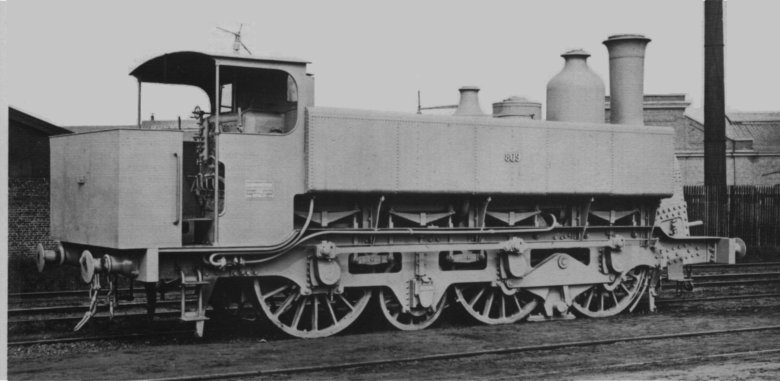Updated: 12 Feb 2003 |   |
Whyte was a Dutch New York Central mechanical engineer. Often seen spelled "F. M. White".
This simple but informative system has coped with almost every thing the adventurous engineer could throw at it. Articulated engines? Simply increase the number of driving wheel descriptors and add a +, so a typical Beyer-Garratt is 4-6-2 + 2-6-4. The Lartigue monorail? No problem, 0-3-0.
The table below gives only the most important Whyte arrangents, with the names that have become associated with them. Many type names were used in the USA only: popular names are shown in bold.
|
|
|
|
| 0-6-0 | OOO | Six-wheel tank | |
| 0-8-0 | OOOO | Eight-wheel tank | |
| 2-6-0 | oOOO | Mogul | USA name |
| 2-6-2 | oOOOo | Prairie | |
| 2-8-0 | oOOOO | Consolidation | |
| 2-8-2 | oOOOOo | Mikado | |
| 2-8-4 | oOOOOoo | Berkshire | |
| 2-10-0 | oOOOOO | Decapod | |
| 2-10-2 | oOOOOOo | Santa Fe | |
| 2-10-4 | oOOOOOoo | Texas | |
| 4-4-0 | ooOO | American | |
| 4-4-2 | ooOOo | Atlantic | |
| 4-6-0 | ooOOO | Ten-Wheeler | |
| 4-6-2 | ooOOOo | Pacific | |
| 4-6-4 | ooOOOoo | Hudson (Baltic) | |
| 4-8-2 | ooOOOOo | Mountain | |
| 4-8-4 | ooOOOOoo | Northern | |
| 2-12-0 | oOOOOOO | | Centipede | |
| 4-14-4 | ooOOOOOOOoo | | The notorious AA20 | |
| 4-6-6-4 | ooOOO OOOoo | Challenger | Mallet articulated. USA |
| 4-6-2 + 2-6-4 | ooOOOo oOOOoo | Garratt | Articulated |
| 4-8-8-4 | ooOOOO OOOOoo | "Big Boy" | Mallet articulated. USA |
However, a few locomotives just won't fit in to this system. Here is one...

So what do we call this little beauty then? 4-2-2 implies two driving wheels, not six, and is clearly wrong. There Goes The System.
This is a Belgian Type #3, No 809. Ten of these were built in 1874 for use on the Luxembourg line, which limited axle loading to 14 tonnes. An extra carrying wheel with lateral play was therefore inserted ahead of the rear driver.
The true connoisseur will note that the extra wheel has been interlinked with the spring balancing of the main wheels. There is a sledge brake between the leading and middle drivers.
The UIC System copes rather better. This is based on the German system, and works thus:
Unpowered axles get a simple number: 1,2,3...
Coupled driving axles get a letter: A, B, C... A = one driving axle, B= 2, C= 3 etc.
Trucks, bogies get a ': 1' = two-wheel truck, 2' = 4-wheel bogie.
Individually driven axles get a o: Bo = two driven axles, Co = three driven axles, etc.
Articulated bits go in brackets: (2'C)C2' is a Mallet articulated Challenger.
There are often often odd letters and figures after the main wheel arrangement:
h means Superheated Steam
n means Saturated (ie unsuperheated) Steam
v means Compound
Turb means Turbine (tricky one, that)
t means Tank locomotive
A number following n or v is the Number of Cylinders
Thus n2T means a tank engine with no superheater and two cylinders.
No 809 above is therefore a B2A. This is more informative, but doesn't tell you that all the powered axles are coupled together.
Here's another test for the Whyte system: Petiet's French Experiment
Is that a 2-6-2? (It's actually a duplex; the outer four wheels are powered, not the inner six)
UIC describes it effortlessly as an A3A


